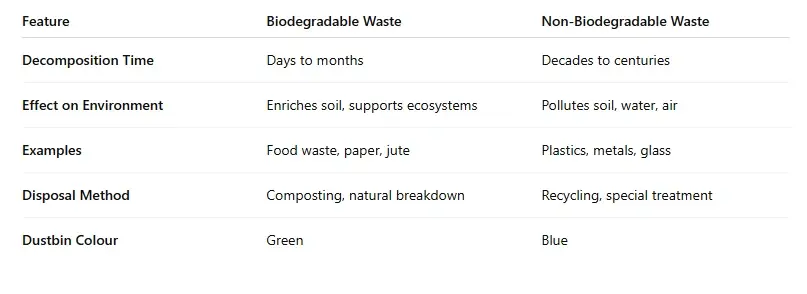Waste is everywhere — from the leftover tea leaves in your kitchen sink to the discarded plastic bottles lying by the roadside. But not all waste is the same. Some waste breaks down naturally and returns to the earth, while others linger for decades, polluting soil, water, and air.
In this guide, we’ll explore what biodegradable and non-biodegradable waste means, how to identify them in your daily life, and how you can make better choices as a conscious consumer with Earth Relief.
1. What is Biodegradable Waste?
Biodegradable waste refers to materials that can be broken down by natural processes — usually by microorganisms like bacteria and fungi — into harmless substances like carbon dioxide, water, and organic matter.
Example of Biodegradable Waste in Indian Homes
Kitchen scraps: vegetable peels, fruit rinds, tea leaves
Garden waste: dried leaves, grass clippings, flowers
Natural fabrics: cotton clothes, jute bags
Paper and cardboard
Food leftovers
Earth Relief Tip: Composting kitchen waste is one of the simplest ways to turn biodegradable waste into nutrient-rich soil for your plants. Our Earth Relief Compost Bins make it odor-free and hassle-free.
2. What is Non-Biodegradable Waste?
Non-biodegradable waste is waste that does not decompose naturally within a reasonable period — sometimes taking hundreds of years or never breaking down completely. These materials often require recycling, safe disposal, or alternative uses to avoid environmental damage.
Example of Non- Biodegradable Waste in Indian Homes
Plastic bags and wrappers
Aluminium foil
Glass bottles
Electronic waste (e-waste) like old chargers
Styrofoam plates and cups
Did you know? A plastic bag can take over 500 years to break down. That’s why Earth Relief Biodegradable Carry Bags are made from cornstarch and decompose within months.
3. Why Understanding the Difference Matters
The accumulation of non-biodegradable waste leads to pollution, clogged drains, soil infertility, and harm to animals who accidentally consume it. In India, where waste segregation is still a challenge, mixing these wastes makes recycling nearly impossible.
A simple household habit — segregating waste into two bins — can reduce landfill pressure by 50%.
Biodegradable Dustbin Colour: Green
Non-Biodegradable Dustbin Colour: Blue
4. Biodegradable vs Non-Biodegradable: A Comparison Table

5. Common Myths
❌ “Plastic is biodegradable if it’s thin.” – Wrong. Thickness doesn’t make it biodegradable.
❌ “All paper is eco-friendly.” – Not true. Laminated or coated paper may be non-biodegradable.
Earth Relief products are certified compostable under Indian and international standards — meaning they truly break down without harming the earth.
6. Real-Life Story: How One Family Reduced 80% of Their Non-Biodegradable Waste
The Sharma family in Ghaziabad switched to Earth Relief’s biodegradable tableware, composted their kitchen waste, and started saying no to single-use plastic. Within 3 months, their blue bin (non-biodegradable waste) was barely half full.
Their motivation? “We wanted our kids to grow up on a cleaner planet,” says Mrs. Sharma.
Read More : https://blogs.earthrelief.in/how-earth-relief-products-are-changing-the-way-we-live-green/
7. How You Can Reduce Non-Biodegradable Waste at Home
Switch to biodegradable carry bags
Use compostable food packaging instead of foil
Avoid single-use plastics — opt for reusable steel, bamboo, or glass
Buy in bulk to reduce packaging waste
Support brands like Earth Relief that use sustainable materials
8. Government Rules in India

Under the Plastic Waste Management Rules, 2022, certain single-use plastics are banned. Cities are also pushing for strict segregation at source — meaning households must separate biodegradable and non-biodegradable waste before disposal.
9. Earth Relief’s Role in Waste Reduction
We at Earth Relief believe every small step counts. Our biodegradable bags, compost bins, and eco-friendly packaging make it easier for Indian households to shift to a sustainable lifestyle without breaking the bank.
🌱 Special Offer: Get Amazing offers on your first order at the Earth Relief Store and start your waste-free journey today.
Conclusion
Knowing the difference between biodegradable and non-biodegradable waste is more than textbook knowledge — it’s a responsibility. By making informed choices and supporting eco-conscious brands like Earth Relief, you can actively help reduce pollution and protect the planet.
